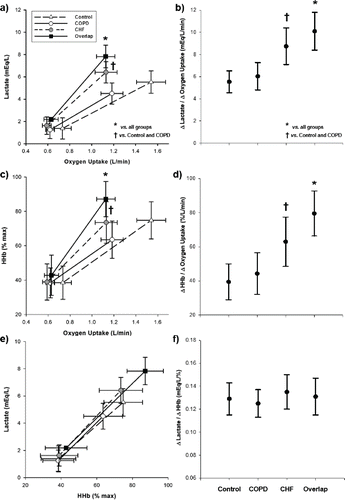Figures & data
Table 1. Subjects’ main characteristics and pharmacological treatment.
Table 2. Resting lung function and responses to incremental exercise.
Table 3. Physiological and sensorial responses to constant work rate exercise test at 80% peak.
Figure 1. Central (panels a and b) and peripheral (panels c and d) hemodynamic responses as a function of exercise intensity and their relationship (panels e and f) in healthy controls and patients with chronic obstructive pulmonary disease (COPD), chronic heart failure (CHF) and COPD-CHF (overlap). “Δ“ is the difference between 20% and 80% peak work rate.

Figure 2. Blood lactate concentration and muscle deoxygenation (HHb) as a function of exercise intensity in healthy controls and patients with chronic obstructive pulmonary disease (COPD), chronic heart failure (CHF) and COPD-CHF (overlap). “Δ“ is the difference between 20% and 80% peak work rate.

Figure 3. Relationship between time to exercise intolerance (Tlim) and changes in muscle blood flow and oxygen uptake () in healthy controls and patients with chronic obstructive pulmonary disease (COPD), chronic heart failure (CHF) and COPD-CHF (overlap). “Δ“ is the difference between 20% and 80% peak work rate.

